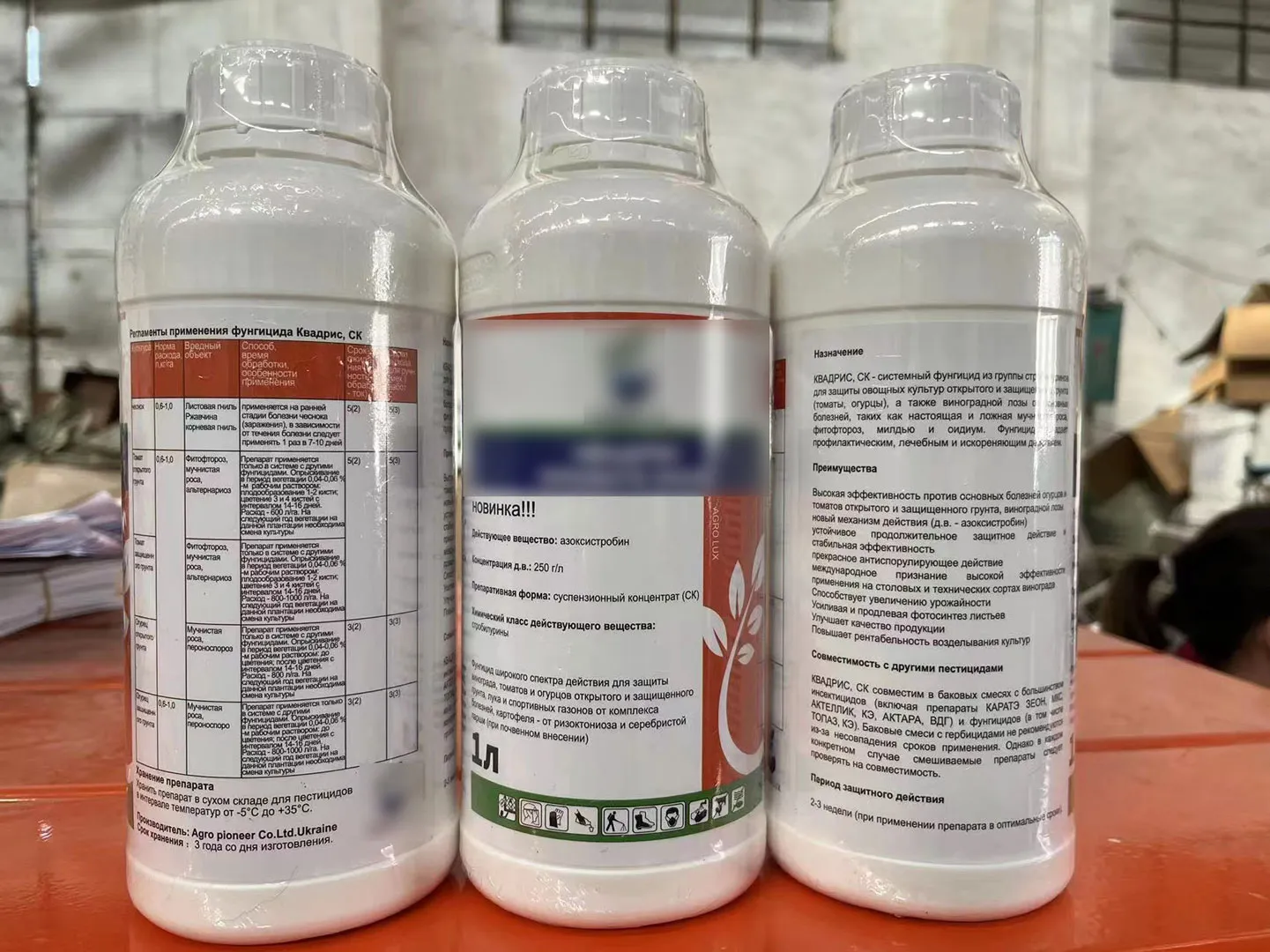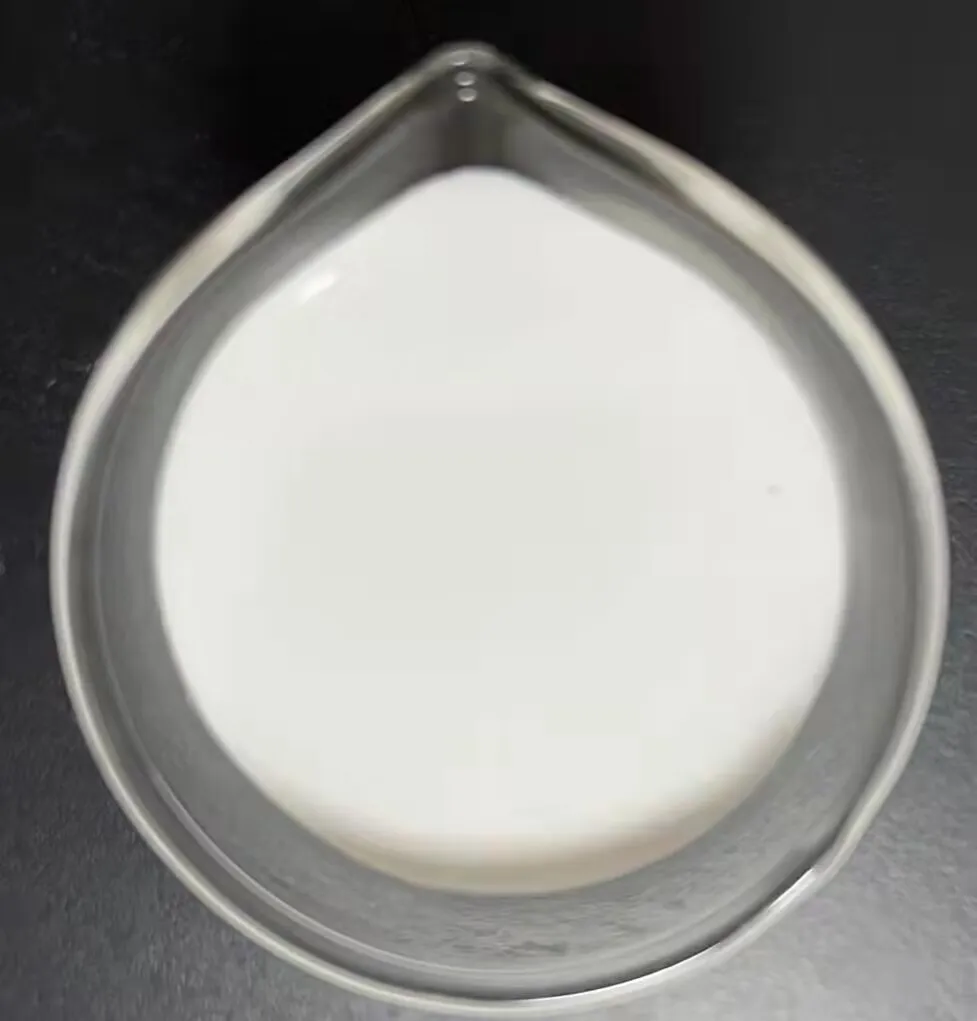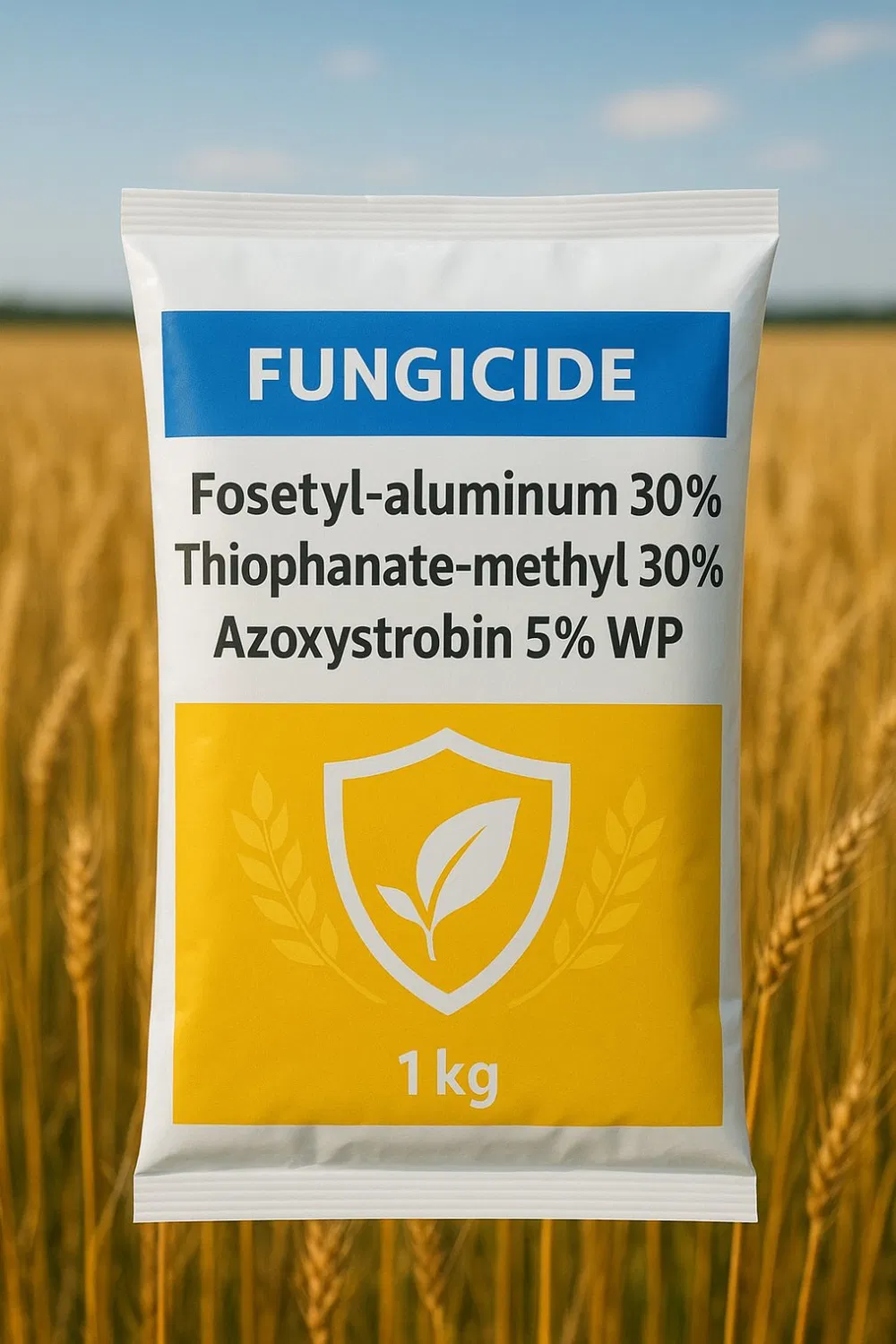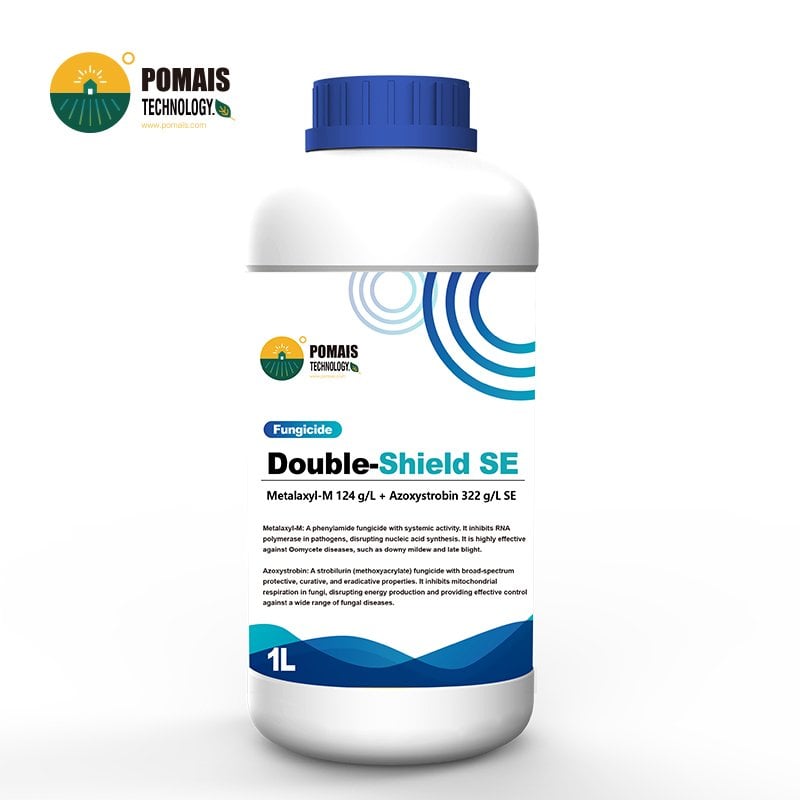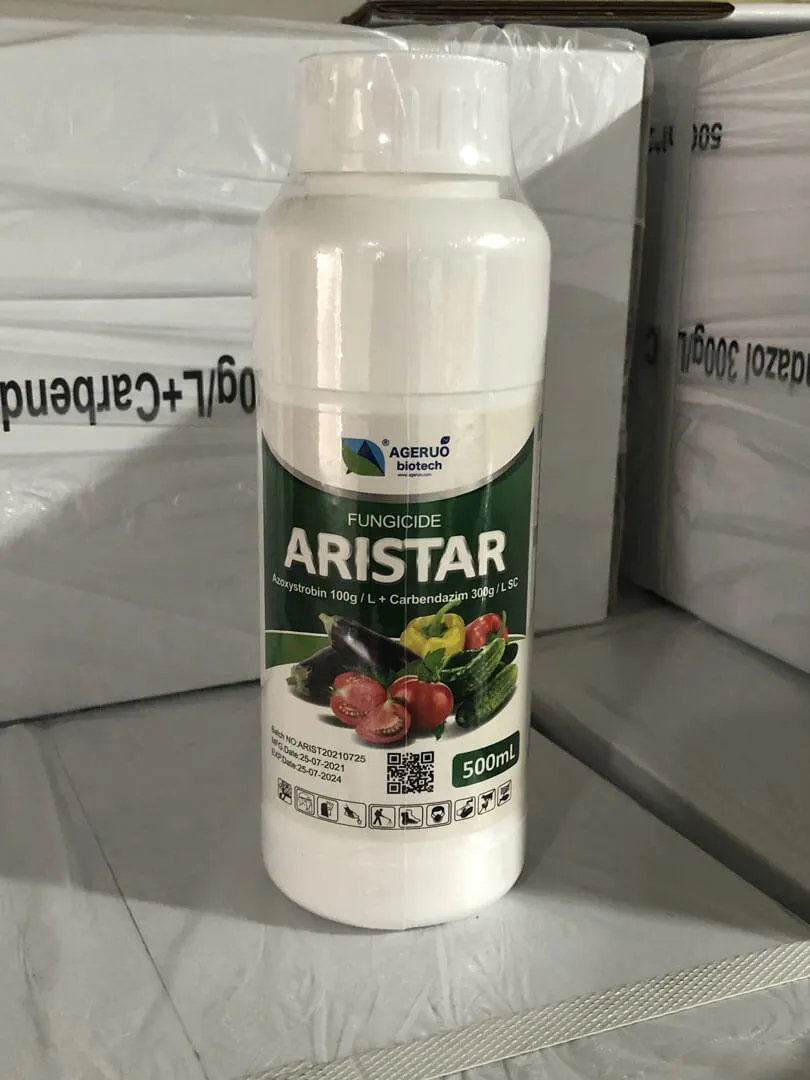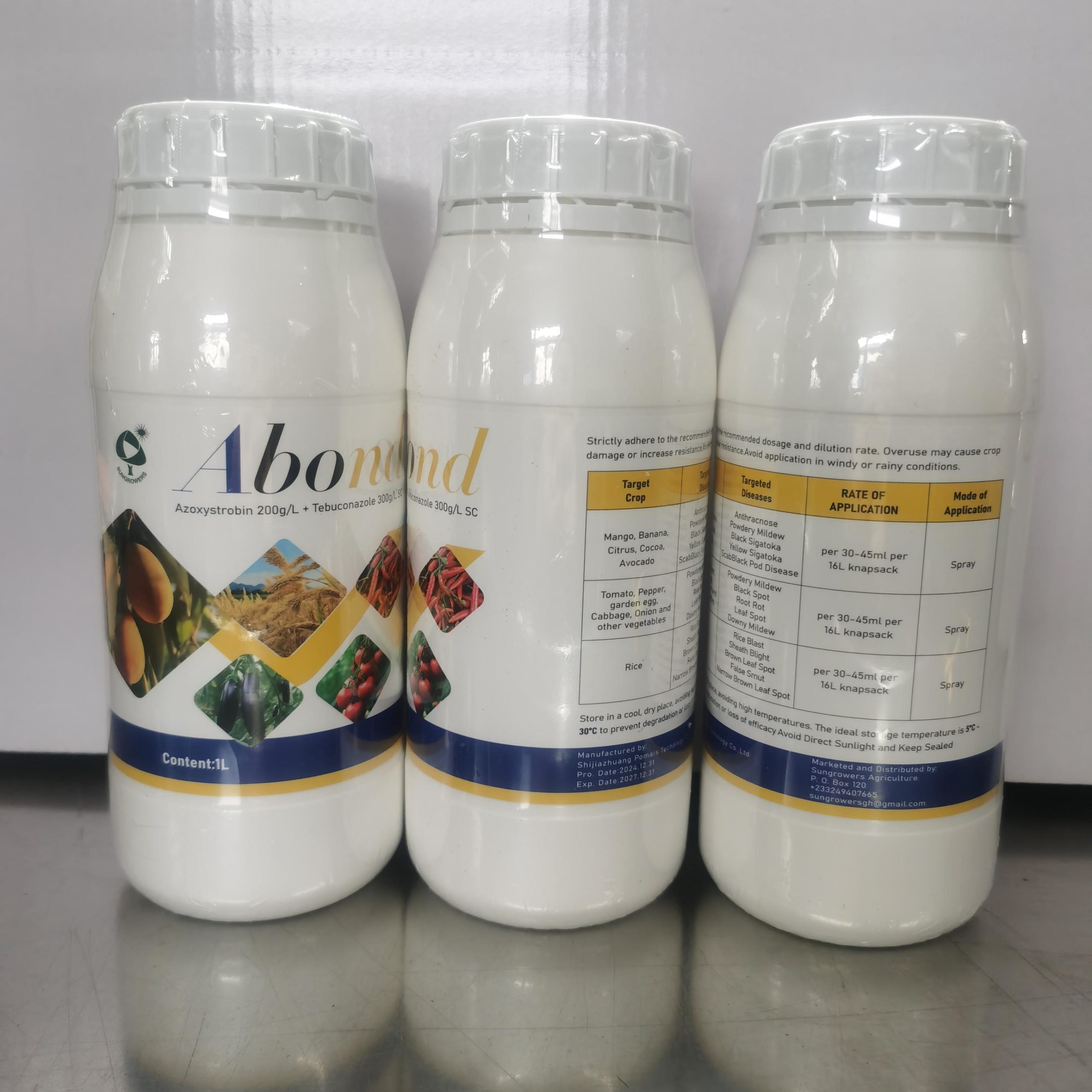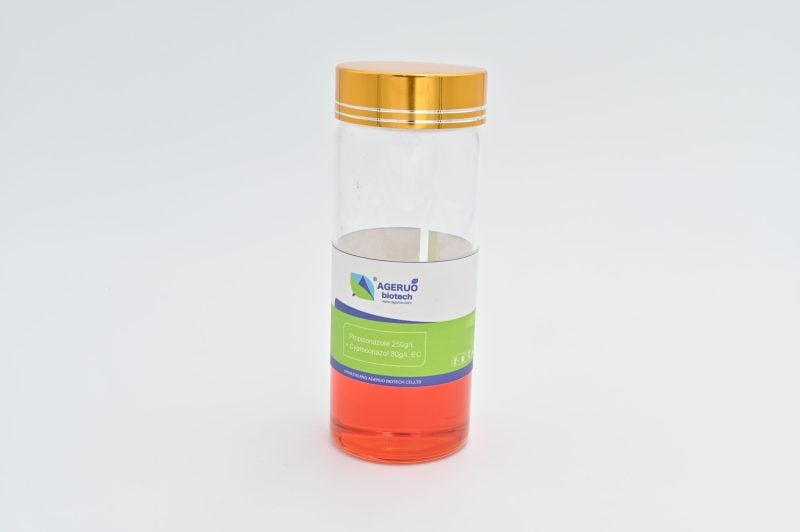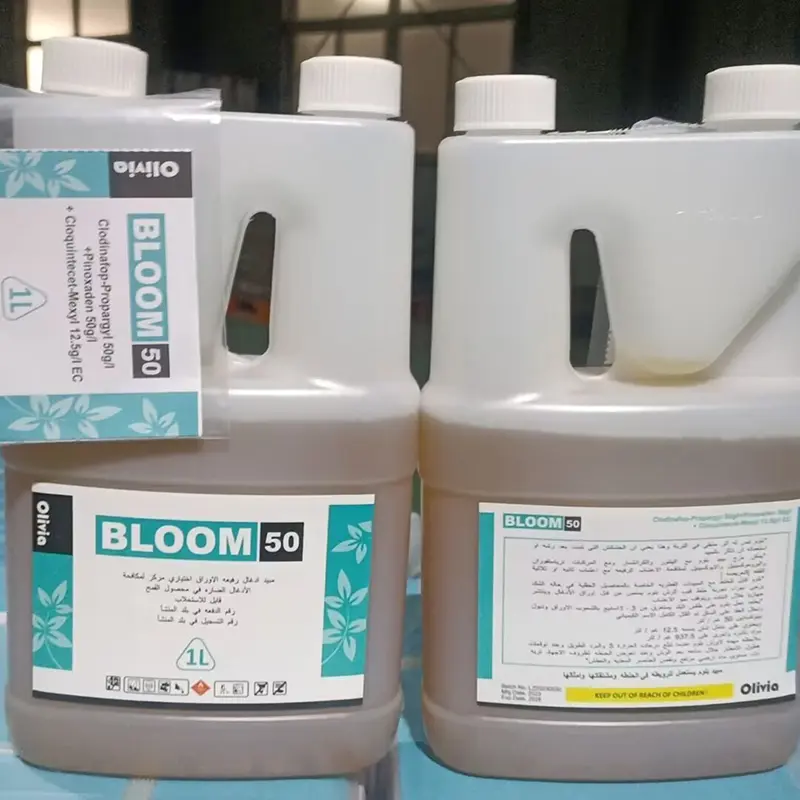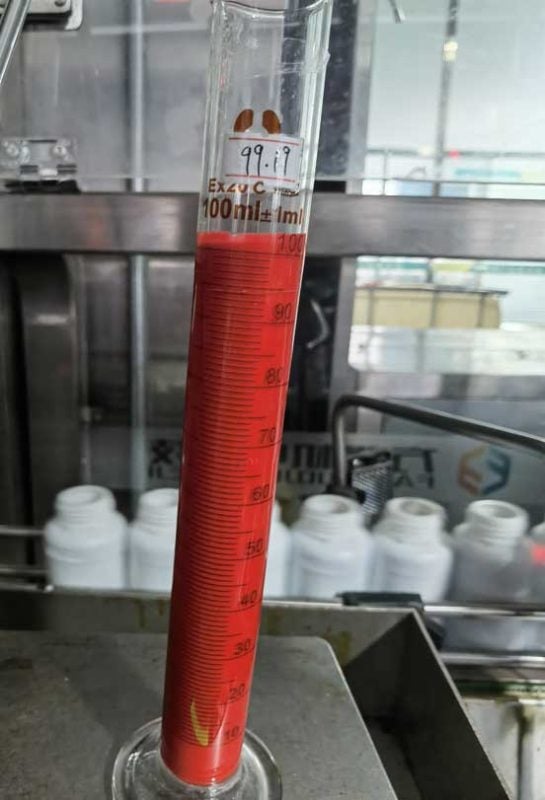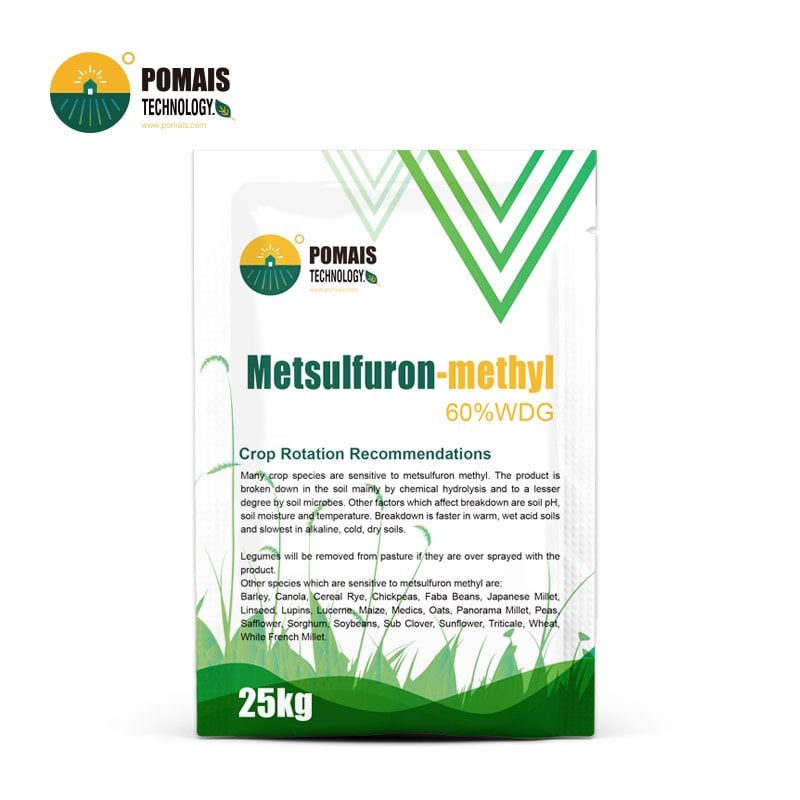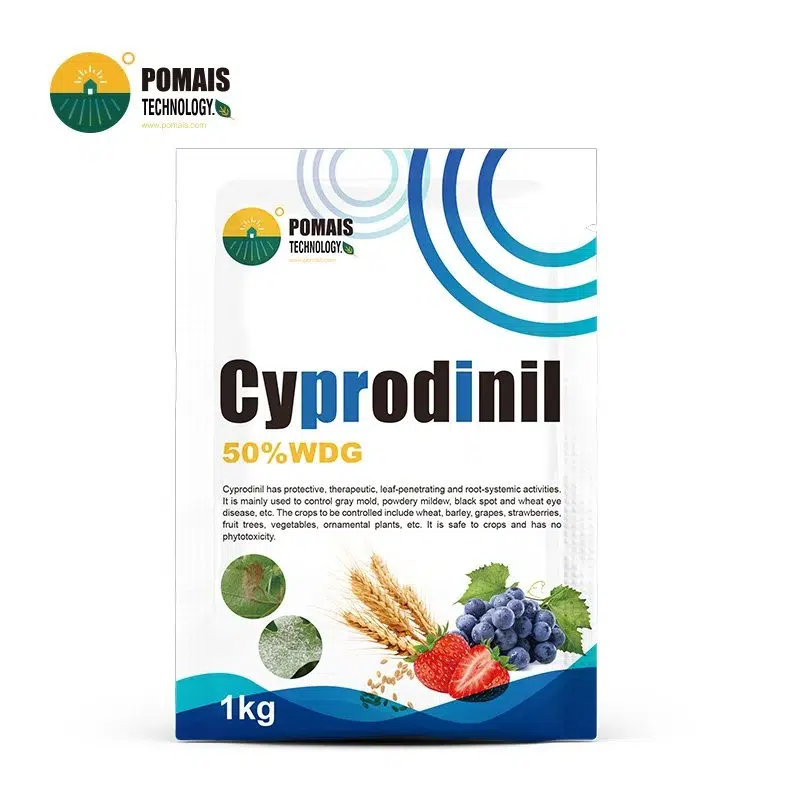Azoxystrobin Fungicide
Broad-Spectrum Disease Control in Agriculture
If you’re looking for a high-performance fungicide to protect your crops against a wide range of fungal diseases, Azoxystrobin offers one of the most trusted solutions in the global agrochemical market. With strong preventive and curative action, this active ingredient is widely used across cereals, fruits, vegetables, and legumes, helping you safeguard your yield from early-stage infections to harvest.
As a systemic fungicide with translaminar and xylem-mobile activity, azoxystrobin ensures deep penetration and long-lasting protection. Whether you’re seeking a formulation for foliar spray, seed treatment, or granular application, this ingredient adapts well to diverse farming systems and climatic conditions.
- Designed for Professional Buyers & Bulk Orders
- This product is available for business purchase and large-scale distribution.
- We support custom packaging, labeling, and formulation to meet your market needs.
- Let’s build your brand together.

About Azoxystrobin Fungicide
About Azoxystrobin Fungicide
| Product Name | Methomyl 90% SP |
| Formulation Type | Soluble Powder (SP) |
| Active Ingredient | Methomyl |
| Concentration | 90% |
| CAS Number | 16752-77-5 |
| Chemical Formula | C5H10N2O2S |
| Molecular Weight | 162.21 g/mol |
| Solubility | High water solubility |
| Mode of Action | Acetylcholinesterase inhibitor; IRAC Group 1A |
| OEM/ODM Capabilities | Custom labels, multilingual packaging, anti-counterfeit printing |
| Packaging Options | 100g–1kg pouches, 25kg drums, private label available |
| Regulatory Support | COA, MSDS, ICAMA dossier, registration assistance |
| Production Capacity | ISO-certified plant, HPLC/GC testing, 2-year stability |
| MOQ & Export Regions | MOQ from 500kg; exported to 56+ countries worldwide |
| Logistics | Flexible shipping from major China ports; LCL or full container |
Azoxystrobin Fungicide for Broad-Spectrum Disease Control in Agriculture
Azoxystrobin is a broad-spectrum, systemic fungicide classified under the strobilurin chemical group (FRAC Group 11). It was originally derived from natural antifungal compounds found in wood-decaying fungi and has since been optimized for agricultural use. This active ingredient disrupts the mitochondrial respiration process in fungi, specifically inhibiting electron transfer at the Qo site of the cytochrome bc1 complex. This mode of action effectively halts energy production in fungal cells, leading to their death.
Azoxystrobin is known for its preventive, curative, and residual activity, making it suitable for both early and late-stage disease control. Thanks to its mobility within plant tissues (translaminar and systemic through the xylem), it offers uniform protection even in hard-to-reach areas of the crop. It is widely used in foliar sprays, seed coatings, and soil-applied formulations across diverse crops.
Mode of Action of Azoxystrobin
Azoxystrobin acts by inhibiting mitochondrial respiration in fungal cells. Specifically, it blocks electron transfer at the Qo (quinol outer) site of the cytochrome bc1 complex within the mitochondrial membrane. This disruption halts the production of ATP, the energy currency of the cell, resulting in immediate energy deficiency and ultimately the death of the fungal pathogen.
What sets azoxystrobin apart is its systemic and translaminar activity. After foliar or seed treatment application, it is absorbed and moves through the plant’s vascular system—mainly via the xylem—ensuring internal protection. Its surface redistribution properties also allow for secondary spreading over plant surfaces through dew or rainfall, making it highly rainfast.
Because it offers preventive, curative, and eradicative activity, azoxystrobin helps you:
- Protect crops before infection occurs,
- Suppress disease development after initial infection,
- Extend residual protection across growth stages.
To minimize the risk of resistance, azoxystrobin is often used in rotation or tank mixes with fungicides from different FRAC groups, especially in IPM (Integrated Pest Management) programs.
Available Formulations & Concentrations of Azoxystrobin
Azoxystrobin is available in a wide range of concentrations and formulations to suit different application methods, crop types, and regulatory markets. Whether you need a seed treatment, foliar spray, or granular product, POMAIS provides flexible options to meet your needs.
Commonly Offered Specifications:
| Product Name | Formulation Type | Concentration | Typical Use |
|---|---|---|---|
| Azoxystrobin 250 g/L SC | Suspension Concentrate (SC) | 25% (w/v) | Foliar spray for cereals, grapes, vegetables |
| Azoxystrobin 50% WG | Water Dispersible Granules (WG) | 50% (w/w) | High-load foliar application for cash crops |
| Azoxystrobin 23% SC | Suspension Concentrate (SC) | 23% | Multipurpose fungicide for broad-spectrum |
| Azoxystrobin 2.5% FS | Flowable Concentrate for Seed Treatment (FS) | 2.5% | Protection at seed germination stage |
| Azoxystrobin 50% WDG | Water Dispersible Granules | 50% | Broad-spectrum systemic control |
| Azoxystrobin 240 SC | Suspension Concentrate | 24% | Widely used in Europe and North America |
| Azoxystrobin Granular | Granule (GR) | Customizable | Soil-applied or turf use |
| Azoxystrobin Technical | Tech grade | ≥97% (purity) | For formulation use |
These formulations are tailored to different application needs, such as:
- SC: Ideal for uniform leaf coverage with excellent crop safety.
- WG/WG: Easy to transport and store, highly concentrated for cost-effective spraying.
- FS: Designed to adhere to seeds with systemic protection at early stages.
- GR: Applied to soil or turf, suitable for nursery and ornamental use.
You can request customized concentrations and packaging based on your market regulations or crop protection requirements.
Key Benefits of Azoxystrobin Fungicide
Choosing azoxystrobin for your crop protection strategy offers a powerful combination of broad-spectrum activity, long residual control, and high crop safety. It is trusted globally for use across a wide range of crops and climatic conditions.
Why You Should Choose Azoxystrobin:
- Broad-Spectrum Control: Effective against major classes of fungal pathogens, including Ascomycetes, Basidiomycetes, and Oomycetes—covering diseases like rust, mildew, blight, and leaf spot.
- Systemic & Translaminar Action: Rapid uptake and movement through the plant’s xylem ensure internal protection of new and existing tissues.
- Residual Protection: Offers 10–21 days of sustained control depending on formulation and weather conditions, reducing spray frequency.
- Rainfastness: Thanks to its lipophilic nature, azoxystrobin resists wash-off within hours of application, ensuring field performance in variable climates.
- High Crop Safety: Demonstrates excellent selectivity across cereals, legumes, vegetables, fruits, and ornamentals—making it compatible with integrated farm plans.
- Flexible Compatibility: Suitable for tank-mixing with other fungicides and insecticides, especially for resistance management in rotation programs.
- Multiple Application Routes: Can be applied via foliar spray, seed treatment, or soil drench, depending on formulation and target crop.
- Market-Proven: Registered and widely used in over 100 countries, making it a globally recognized molecule supported by regulatory frameworks and performance data.
Whether you’re a distributor sourcing a reliable fungicide or a grower protecting high-value crops, azoxystrobin gives you the performance and flexibility needed for modern agriculture.
Target Crops & Fungal Diseases Controlled
Azoxystrobin is widely recognized for its efficacy across a broad range of crops. Whether used in field crops, horticulture, fruit production, or turf management, it effectively prevents and controls over 60 fungal diseases that threaten crop yield and quality.
Suitable for the Following Crops:
- Cereal crops: wheat, barley, oats, corn (maize), rice, sorghum
- Vegetables: tomato, cucumber, lettuce, onion, potato, cabbage, carrot, beans, peas
- Fruits: grapes, apples, citrus, bananas, strawberries, melons
- Oil crops: soybean, sunflower, rapeseed (canola)
- Cash crops: tobacco, cotton, peanuts, sugarcane
- Turf and ornamentals: golf courses, lawns, decorative plants
Key Fungal Diseases Controlled:
| Disease Type | Example Pathogens / Symptoms | Crop Examples |
|---|---|---|
| Powdery Mildew | Erysiphe spp., white powder on leaves | Grapes, cucurbits, cereals |
| Downy Mildew | Plasmopara spp., leaf yellowing and necrosis | Lettuce, onions, cucurbits |
| Rust | Puccinia spp., orange/brown pustules on stems and leaves | Wheat, beans, maize |
| Leaf Spot / Blight | Alternaria spp., Septoria spp., necrotic leaf lesions | Tomatoes, potatoes, soybeans |
| Anthracnose | Colletotrichum spp., dark sunken lesions on fruit/leaves | Fruits, legumes, peppers |
| Late Blight | Phytophthora infestans, leaf and tuber rot | Potatoes, tomatoes |
| Gray Mold (Botrytis) | Botrytis cinerea, fuzzy gray spores | Strawberries, flowers, grapes |
| Sheath Blight | Rhizoctonia solani, rotting at leaf bases | Rice |
| Fusarium Wilt / Root Rot | Fusarium spp., vascular wilting and root decay | Bananas, tomatoes, cotton |
Azoxystrobin’s broad disease spectrum, combined with systemic movement and residual efficacy, makes it an essential tool for growers across different climates and geographies.
Application Methods & Recommended Dosage
Depending on the formulation and target crop, azoxystrobin can be applied via foliar spray, soil treatment, or seed coating. To ensure optimal disease control and avoid resistance development, you should apply it according to the recommended rate and interval, and follow regional agricultural guidelines.
Foliar Spray Recommendations
| Formulation | Dosage | Application Timing | Remarks |
|---|---|---|---|
| Azoxystrobin 250 g/L SC | 200–300 mL/ha | Early onset of disease or preventive stage | Ensure even coverage of foliage |
| Azoxystrobin 23% SC | 300–500 mL/ha | Pre- or post-infection | Effective against rusts and blights |
| Azoxystrobin 50% WG | 150–250 g/ha | Pre-symptom phase | Strong against powdery mildew |
| Azoxystrobin 50% WDG | 100–200 g/ha | Within 10 days of planting | Ideal for vegetables and high-value crops |
Seed Treatment Dosage
| Formulation | Dosage | Application Method | Remarks |
|---|---|---|---|
| Azoxystrobin 2.5% FS | 5–10 mL/kg seed | Coat uniformly before sowing | Protects against seed- and soil-borne fungi |
Granular Use (Soil Incorporation or Broadcast)
| Formulation | Dosage | Application Method | Remarks |
|---|---|---|---|
| Azoxystrobin Granular | 2–5 kg/ha | Soil surface or banded row | Suitable for turf, vegetables, ornamentals |
Tips for Optimal Use:
- Apply preventively or at early infection stages for maximum efficacy.
- Use with adjuvants if high rainfastness is required.
- Rotate with other fungicides (different MoA) to reduce resistance risk.
Always refer to local label guidelines and field conditions before application. Customized dosage recommendations are available based on your crop, climate, and product formulation.
Tank Mix Compatibility & Resistance Management
Azoxystrobin exhibits excellent tank mix compatibility with a wide range of fungicides, insecticides, and foliar fertilizers, making it highly flexible in integrated spray programs. Its systemic properties and broad-spectrum activity allow it to be used alone or in rotation to manage fungal resistance across different cropping systems.
Tank Mix Compatibility
Azoxystrobin 250g/L SC and other formulations can be mixed with:
- Contact fungicides: e.g., mancozeb, chlorothalonil (for enhanced preventive control)
- Systemic fungicides with different MoA: e.g., difenoconazole, tebuconazole, fludioxonil (for rotation)
- Insecticides: e.g., thiamethoxam, imidacloprid (for simultaneous pest and disease control)
- Foliar nutrients: micronutrient fertilizers, amino acids, seaweed extracts
Before large-scale use, always conduct a jar test to confirm physical compatibility, and follow label instructions for water pH, mixing sequence, and spray volume.
Resistance Management Strategy
Azoxystrobin belongs to the QoI (quinone outside inhibitor) group—FRAC Group 11—characterized by single-site mode of action. To avoid the buildup of resistant fungal strains:
- Rotate with fungicides from different FRAC groups (e.g., Group 3 or Group 7)
- Limit the number of consecutive applications per crop cycle (usually 2 per season)
- Use as part of an Integrated Pest Management (IPM) program
- Apply at recommended label rates to maintain effective dose exposure
Adopting a proper resistance strategy not only extends the lifespan of azoxystrobin but also supports sustainable farming practices for your customers and growers.
Safety & Environmental Behavior
Azoxystrobin is widely regarded as one of the most environmentally considerate fungicides among modern strobilurin compounds. When used correctly, it offers high efficacy with minimal ecological disruption and excellent crop tolerance.
Toxicological Profile
| Parameter | Details |
|---|---|
| Acute Oral Toxicity (LD50, rats) | >5000 mg/kg – low toxicity |
| Dermal Toxicity (LD50, rabbits) | >2000 mg/kg – low skin absorption |
| Eye Irritation | Slight, reversible |
| Skin Irritation | Non-irritant |
| WHO Toxicity Classification | Class III – Slightly hazardous |
Azoxystrobin is non-carcinogenic, non-mutagenic, and exhibits no reproductive toxicity, making it safe for use in various food and feed crops under regulated application.
Environmental Behavior
- Low Leaching Risk: Due to moderate soil adsorption and low water solubility, azoxystrobin shows limited movement in groundwater.
- Biodegradability: It breaks down naturally under field conditions, minimizing long-term residue accumulation.
- Low Volatility: Ensures minimal drift during spray application, reducing off-target impact.
- Aquatic Toxicity Caution: While relatively safe for terrestrial life, care must be taken to avoid contamination of aquatic environments.
Residue and Pre-Harvest Interval (PHI)
- Typical PHI: 7–21 days depending on the crop and formulation
- Residue Compliance: Registered for use with established MRLs (Maximum Residue Limits) in over 80 countries, including EU, US, China, and Brazil
Azoxystrobin is also approved for use in integrated and sustainable farming systems, including Global GAP and organic-compliant programs when used as part of resistance-managed rotation.
Packaging & OEM Options
As a professional agrochemical manufacturer and exporter, we understand that packaging is not just about logistics—it’s about brand presence, product protection, and market adaptability. Our azoxystrobin fungicide products are available in a wide range of packaging formats and can be fully customized to meet your local market preferences, regulatory requirements, and distribution channels.
Available Packaging Options
| Formulation Type | Standard Package Sizes |
|---|---|
| Suspension Concentrate (SC) | 100mL, 250mL, 500mL, 1L, 5L, 20L HDPE/CO-EX bottles/drums |
| Wettable Granule (WG) | 100g, 250g, 500g, 1kg, 5kg, 10kg foil pouches or cartons |
| Water-Dispersible Granules | 200g, 1kg, 5kg, 25kg fiber drums, kraft paper bags |
| Seed Treatment Formulations | 100mL, 200mL, 1L with measuring caps and child-proof lids |
All packaging is compliant with international shipping standards, moisture-proof, UV-resistant, and designed for safe storage and handling.
OEM & Branding Capabilities
- Private Labeling: We offer full-service OEM production with your brand name, logo, and artwork.
- Multilingual Label Design: Support for English, Spanish, French, Arabic, Russian, and more.
- Regulatory Document Support: COA, MSDS, TDS, SGS Test Reports, and registration dossiers available.
- Flexible MOQs: From trial orders to container-scale shipments, we adapt to your sourcing strategy.
- Anti-Counterfeit Solutions: Holographic labels, QR code traceability, and tamper-proof sealing.
Whether you are a global brand owner, a regional distributor, or a government tender participant, we can tailor azoxystrobin fungicide packaging and branding to align with your market and compliance needs.
Regulatory Support & Global Market Compliance
With years of experience exporting azoxystrobin fungicide to diverse international markets, we provide comprehensive regulatory support to ensure your product complies with the legal frameworks of your target country. Our technical team is familiar with the registration procedures and dossier requirements across major agricultural regions.
Global Registration Experience
We have successfully supported azoxystrobin registration in over 40 countries, including:
- Latin America: Brazil (MAPA), Colombia (ICA), Peru (SENASA)
- Africa: Kenya (PCPB), Egypt (ALIC), Ghana (EPA)
- Middle East: Saudi Arabia (SFDA), Jordan (JPRC), Iran
- Asia: Vietnam, Pakistan, Bangladesh, Philippines
- CIS & Russia: Russia, Ukraine, Kazakhstan
- Europe: EU reference dossier for equivalent evaluation
Dossier Support & Documentation
For azoxystrobin 250g/L SC, 50% WG, seed treatment, and other formulations, we can provide:
- Complete Dossier Preparation: Including 5-batch analysis, toxicology reports, field efficacy data
- GLP & OECD-Compliant Studies: From certified labs
- Label & MSDS Customization: Country-specific formats and languages
- Product Sample & Trial Support: For in-field demo or authority evaluation
Market-Specific Adjustments
- MRL Awareness: We ensure all formulations conform to regional Maximum Residue Limits (e.g., EU, Codex, EPA)
- Packaging Legal Compliance: Including barcodes, hazard classifications, and safety icons
- Formulation Stability Reports: Under local climatic conditions (e.g., tropical stability testing)
Our team works closely with local partners, importers, and consultants to fast-track the registration process and reduce your time-to-market.
Use Case Scenarios & Field Application
Azoxystrobin fungicide has demonstrated consistent, reliable performance across a wide spectrum of field and greenhouse crops in various climates. Whether you’re operating in humid tropics, temperate zones, or arid regions, its systemic protection and translaminar action make it an ideal choice for integrated disease management.
Real-World Application Scenarios
- Grapevines (France / Chile / South Africa)
Applied at pre-bloom and post-bloom stages, azoxystrobin 250g/L SC significantly reduced powdery mildew and downy mildew, maintaining premium fruit quality and yield. - Rice (Southeast Asia)
Used preventively during vegetative stages, it controls blast disease (Magnaporthe oryzae) and sheath blight, especially under humid and high-pressure conditions. - Potatoes (Eastern Europe / China)
Provides strong protection against early blight and late blight, especially in multi-cycle programs when rotated with Group 3 fungicides. - Bananas (Ecuador / Philippines)
Demonstrated excellent control of Sigatoka leaf spot, improving leaf longevity and export-grade fruit formation. - Ornamentals (Greenhouse/Nurseries)
Offers low phytotoxicity and broad-spectrum control for various foliar fungal diseases, including rusts, leaf spots, and anthracnose on roses, chrysanthemums, and gerberas.
Application Tips
- Always ensure even spray coverage, particularly on the lower canopy and leaf undersides.
- Best results are observed when azoxystrobin is used preventively or at early signs of disease.
- May be integrated with adjuvants to improve leaf retention in high-rainfall regions.
These diverse field examples showcase azoxystrobin’s flexibility, consistency, and compatibility with a wide range of agricultural environments and IPM programs.
FAQ – Frequently Asked Questions
1. What is the most common formulation of azoxystrobin you offer?
We mainly supply azoxystrobin 250g/L SC, 50% WG, 2.5% SC, and seed treatment products, depending on your crop and application method.
2. Can you provide free samples for quality evaluation?
Yes, free samples are available upon request. We can ship small trial quantities along with supporting documents such as COA, TDS, and SDS.
3. Is azoxystrobin safe for use in IPM (Integrated Pest Management) programs?
Absolutely. Azoxystrobin has a favorable safety profile and works well within IPM frameworks. It is compatible with many biological and chemical partners and suitable for resistance management strategies.
4. Do you offer support for local registration in my country?
Yes, we provide full regulatory support, including GLP-compliant dossiers, field trial data, five-batch analysis, and assistance with label design and documentation in required languages.
5. What packaging sizes are available?
We offer flexible packaging options:
- Liquid: 100mL, 250mL, 500mL, 1L, 5L, 20L, 200L
- Solid: 100g, 250g, 500g, 1kg, 25kg
Customized branding and private label options are available.
6. What is the shelf life and storage recommendation?
Shelf life is 2 years when stored in a cool, dry, and well-ventilated area away from direct sunlight and food items.
7. How quickly can you ship after confirming the order?
Our standard lead time is 10–15 working days after confirming label and packaging. Urgent orders can be prioritized depending on stock availability and port access.
Why Choose POMAIS – Manufacturer Advantage & Global Services
POMAIS is a leading manufacturer of azoxystrobin fungicide solutions in China, with a strong record of supplying high-performance formulations to importers, agrochemical distributors, brand owners, agricultural supply chains, and government-backed procurement programs. Our strength lies not only in production capacity, but also in our ability to support your business with consistent quality, regulatory expertise, and flexible services.
Extensive Formulation Capabilities
We produce a full range of azoxystrobin-based products including:
- Technical grade azoxystrobin
- 250g/L SC, 50% WG, 2.5% SC, seed treatment and custom formulations
- Tested for stability, dispersion, and bioavailability using HPLC and GC equipment
Customized Packaging and Branding Solutions
We offer:
- Multilingual labeling, tamper-evident packaging, and design matching your target market
- Wide packaging volumes: from 100mL to 200L for liquids, 100g to 25kg for solids
- OEM and ODM programs that align with your commercial strategy
Full Regulatory Compliance Support
We assist with:
- ICAMA registration documents, five-batch analysis, and GLP-certified data
- Local adaptation support for label design, dossiers, and field trials
- Proven export record across Africa, Latin America, Southeast Asia, and Eastern Europe
Reliable Export Logistics
- Stable long-term freight routes to over 60 countries
- Flexible shipment modes: LCL, FCL, CIF, DDP, and port-to-door delivery
- Professional handling of MSDS, COA, and phytosanitary certificates
Client-Centric Service Structure
Whether you are an agricultural input supplier, national distributor, retail network, or private-label brand, POMAIS provides:
- Responsive communication
- Market-specific solutions
- Long-term cooperation support
With POMAIS, you gain a professional manufacturing partner who understands your regulatory landscape, delivers consistent quality, and helps you expand your product portfolio with confidence.
Request Your Quote or Sample Today
Looking to expand your fungicide portfolio with a trusted azoxystrobin product line? Whether you need a ready-to-market formulation or a fully customized solution, POMAIS is here to support your growth.
We provide:
- Fast quotation within 24 hours
- Free samples for evaluation
- Full support on product registration and documentation
- Custom packaging tailored to your local market preferences
Let us know your required formulation, target crops, or preferred packaging sizes—our team will assist you from consultation to delivery.
Partner with POMAIS and bring reliable, high-performing azoxystrobin fungicides to your market.
| Product Name | Methomyl 90% SP |
| Formulation Type | Soluble Powder (SP) |
| Active Ingredient | Methomyl |
| Concentration | 90% |
| CAS Number | 16752-77-5 |
| Chemical Formula | C5H10N2O2S |
| Molecular Weight | 162.21 g/mol |
| Solubility | High water solubility |
| Mode of Action | Acetylcholinesterase inhibitor; IRAC Group 1A |
| OEM/ODM Capabilities | Custom labels, multilingual packaging, anti-counterfeit printing |
| Packaging Options | 100g–1kg pouches, 25kg drums, private label available |
| Regulatory Support | COA, MSDS, ICAMA dossier, registration assistance |
| Production Capacity | ISO-certified plant, HPLC/GC testing, 2-year stability |
| MOQ & Export Regions | MOQ from 500kg; exported to 56+ countries worldwide |
| Logistics | Flexible shipping from major China ports; LCL or full container |
Azoxystrobin Fungicide for Broad-Spectrum Disease Control in Agriculture
Azoxystrobin is a broad-spectrum, systemic fungicide classified under the strobilurin chemical group (FRAC Group 11). It was originally derived from natural antifungal compounds found in wood-decaying fungi and has since been optimized for agricultural use. This active ingredient disrupts the mitochondrial respiration process in fungi, specifically inhibiting electron transfer at the Qo site of the cytochrome bc1 complex. This mode of action effectively halts energy production in fungal cells, leading to their death.
Azoxystrobin is known for its preventive, curative, and residual activity, making it suitable for both early and late-stage disease control. Thanks to its mobility within plant tissues (translaminar and systemic through the xylem), it offers uniform protection even in hard-to-reach areas of the crop. It is widely used in foliar sprays, seed coatings, and soil-applied formulations across diverse crops.
Mode of Action of Azoxystrobin
Azoxystrobin acts by inhibiting mitochondrial respiration in fungal cells. Specifically, it blocks electron transfer at the Qo (quinol outer) site of the cytochrome bc1 complex within the mitochondrial membrane. This disruption halts the production of ATP, the energy currency of the cell, resulting in immediate energy deficiency and ultimately the death of the fungal pathogen.
What sets azoxystrobin apart is its systemic and translaminar activity. After foliar or seed treatment application, it is absorbed and moves through the plant’s vascular system—mainly via the xylem—ensuring internal protection. Its surface redistribution properties also allow for secondary spreading over plant surfaces through dew or rainfall, making it highly rainfast.
Because it offers preventive, curative, and eradicative activity, azoxystrobin helps you:
- Protect crops before infection occurs,
- Suppress disease development after initial infection,
- Extend residual protection across growth stages.
To minimize the risk of resistance, azoxystrobin is often used in rotation or tank mixes with fungicides from different FRAC groups, especially in IPM (Integrated Pest Management) programs.
Available Formulations & Concentrations of Azoxystrobin
Azoxystrobin is available in a wide range of concentrations and formulations to suit different application methods, crop types, and regulatory markets. Whether you need a seed treatment, foliar spray, or granular product, POMAIS provides flexible options to meet your needs.
Commonly Offered Specifications:
| Product Name | Formulation Type | Concentration | Typical Use |
|---|---|---|---|
| Azoxystrobin 250 g/L SC | Suspension Concentrate (SC) | 25% (w/v) | Foliar spray for cereals, grapes, vegetables |
| Azoxystrobin 50% WG | Water Dispersible Granules (WG) | 50% (w/w) | High-load foliar application for cash crops |
| Azoxystrobin 23% SC | Suspension Concentrate (SC) | 23% | Multipurpose fungicide for broad-spectrum |
| Azoxystrobin 2.5% FS | Flowable Concentrate for Seed Treatment (FS) | 2.5% | Protection at seed germination stage |
| Azoxystrobin 50% WDG | Water Dispersible Granules | 50% | Broad-spectrum systemic control |
| Azoxystrobin 240 SC | Suspension Concentrate | 24% | Widely used in Europe and North America |
| Azoxystrobin Granular | Granule (GR) | Customizable | Soil-applied or turf use |
| Azoxystrobin Technical | Tech grade | ≥97% (purity) | For formulation use |
These formulations are tailored to different application needs, such as:
- SC: Ideal for uniform leaf coverage with excellent crop safety.
- WG/WG: Easy to transport and store, highly concentrated for cost-effective spraying.
- FS: Designed to adhere to seeds with systemic protection at early stages.
- GR: Applied to soil or turf, suitable for nursery and ornamental use.
You can request customized concentrations and packaging based on your market regulations or crop protection requirements.
Key Benefits of Azoxystrobin Fungicide
Choosing azoxystrobin for your crop protection strategy offers a powerful combination of broad-spectrum activity, long residual control, and high crop safety. It is trusted globally for use across a wide range of crops and climatic conditions.
Why You Should Choose Azoxystrobin:
- Broad-Spectrum Control: Effective against major classes of fungal pathogens, including Ascomycetes, Basidiomycetes, and Oomycetes—covering diseases like rust, mildew, blight, and leaf spot.
- Systemic & Translaminar Action: Rapid uptake and movement through the plant’s xylem ensure internal protection of new and existing tissues.
- Residual Protection: Offers 10–21 days of sustained control depending on formulation and weather conditions, reducing spray frequency.
- Rainfastness: Thanks to its lipophilic nature, azoxystrobin resists wash-off within hours of application, ensuring field performance in variable climates.
- High Crop Safety: Demonstrates excellent selectivity across cereals, legumes, vegetables, fruits, and ornamentals—making it compatible with integrated farm plans.
- Flexible Compatibility: Suitable for tank-mixing with other fungicides and insecticides, especially for resistance management in rotation programs.
- Multiple Application Routes: Can be applied via foliar spray, seed treatment, or soil drench, depending on formulation and target crop.
- Market-Proven: Registered and widely used in over 100 countries, making it a globally recognized molecule supported by regulatory frameworks and performance data.
Whether you’re a distributor sourcing a reliable fungicide or a grower protecting high-value crops, azoxystrobin gives you the performance and flexibility needed for modern agriculture.
Target Crops & Fungal Diseases Controlled
Azoxystrobin is widely recognized for its efficacy across a broad range of crops. Whether used in field crops, horticulture, fruit production, or turf management, it effectively prevents and controls over 60 fungal diseases that threaten crop yield and quality.
Suitable for the Following Crops:
- Cereal crops: wheat, barley, oats, corn (maize), rice, sorghum
- Vegetables: tomato, cucumber, lettuce, onion, potato, cabbage, carrot, beans, peas
- Fruits: grapes, apples, citrus, bananas, strawberries, melons
- Oil crops: soybean, sunflower, rapeseed (canola)
- Cash crops: tobacco, cotton, peanuts, sugarcane
- Turf and ornamentals: golf courses, lawns, decorative plants
Key Fungal Diseases Controlled:
| Disease Type | Example Pathogens / Symptoms | Crop Examples |
|---|---|---|
| Powdery Mildew | Erysiphe spp., white powder on leaves | Grapes, cucurbits, cereals |
| Downy Mildew | Plasmopara spp., leaf yellowing and necrosis | Lettuce, onions, cucurbits |
| Rust | Puccinia spp., orange/brown pustules on stems and leaves | Wheat, beans, maize |
| Leaf Spot / Blight | Alternaria spp., Septoria spp., necrotic leaf lesions | Tomatoes, potatoes, soybeans |
| Anthracnose | Colletotrichum spp., dark sunken lesions on fruit/leaves | Fruits, legumes, peppers |
| Late Blight | Phytophthora infestans, leaf and tuber rot | Potatoes, tomatoes |
| Gray Mold (Botrytis) | Botrytis cinerea, fuzzy gray spores | Strawberries, flowers, grapes |
| Sheath Blight | Rhizoctonia solani, rotting at leaf bases | Rice |
| Fusarium Wilt / Root Rot | Fusarium spp., vascular wilting and root decay | Bananas, tomatoes, cotton |
Azoxystrobin’s broad disease spectrum, combined with systemic movement and residual efficacy, makes it an essential tool for growers across different climates and geographies.
Application Methods & Recommended Dosage
Depending on the formulation and target crop, azoxystrobin can be applied via foliar spray, soil treatment, or seed coating. To ensure optimal disease control and avoid resistance development, you should apply it according to the recommended rate and interval, and follow regional agricultural guidelines.
Foliar Spray Recommendations
| Formulation | Dosage | Application Timing | Remarks |
|---|---|---|---|
| Azoxystrobin 250 g/L SC | 200–300 mL/ha | Early onset of disease or preventive stage | Ensure even coverage of foliage |
| Azoxystrobin 23% SC | 300–500 mL/ha | Pre- or post-infection | Effective against rusts and blights |
| Azoxystrobin 50% WG | 150–250 g/ha | Pre-symptom phase | Strong against powdery mildew |
| Azoxystrobin 50% WDG | 100–200 g/ha | Within 10 days of planting | Ideal for vegetables and high-value crops |
Seed Treatment Dosage
| Formulation | Dosage | Application Method | Remarks |
|---|---|---|---|
| Azoxystrobin 2.5% FS | 5–10 mL/kg seed | Coat uniformly before sowing | Protects against seed- and soil-borne fungi |
Granular Use (Soil Incorporation or Broadcast)
| Formulation | Dosage | Application Method | Remarks |
|---|---|---|---|
| Azoxystrobin Granular | 2–5 kg/ha | Soil surface or banded row | Suitable for turf, vegetables, ornamentals |
Tips for Optimal Use:
- Apply preventively or at early infection stages for maximum efficacy.
- Use with adjuvants if high rainfastness is required.
- Rotate with other fungicides (different MoA) to reduce resistance risk.
Always refer to local label guidelines and field conditions before application. Customized dosage recommendations are available based on your crop, climate, and product formulation.
Tank Mix Compatibility & Resistance Management
Azoxystrobin exhibits excellent tank mix compatibility with a wide range of fungicides, insecticides, and foliar fertilizers, making it highly flexible in integrated spray programs. Its systemic properties and broad-spectrum activity allow it to be used alone or in rotation to manage fungal resistance across different cropping systems.
Tank Mix Compatibility
Azoxystrobin 250g/L SC and other formulations can be mixed with:
- Contact fungicides: e.g., mancozeb, chlorothalonil (for enhanced preventive control)
- Systemic fungicides with different MoA: e.g., difenoconazole, tebuconazole, fludioxonil (for rotation)
- Insecticides: e.g., thiamethoxam, imidacloprid (for simultaneous pest and disease control)
- Foliar nutrients: micronutrient fertilizers, amino acids, seaweed extracts
Before large-scale use, always conduct a jar test to confirm physical compatibility, and follow label instructions for water pH, mixing sequence, and spray volume.
Resistance Management Strategy
Azoxystrobin belongs to the QoI (quinone outside inhibitor) group—FRAC Group 11—characterized by single-site mode of action. To avoid the buildup of resistant fungal strains:
- Rotate with fungicides from different FRAC groups (e.g., Group 3 or Group 7)
- Limit the number of consecutive applications per crop cycle (usually 2 per season)
- Use as part of an Integrated Pest Management (IPM) program
- Apply at recommended label rates to maintain effective dose exposure
Adopting a proper resistance strategy not only extends the lifespan of azoxystrobin but also supports sustainable farming practices for your customers and growers.
Safety & Environmental Behavior
Azoxystrobin is widely regarded as one of the most environmentally considerate fungicides among modern strobilurin compounds. When used correctly, it offers high efficacy with minimal ecological disruption and excellent crop tolerance.
Toxicological Profile
| Parameter | Details |
|---|---|
| Acute Oral Toxicity (LD50, rats) | >5000 mg/kg – low toxicity |
| Dermal Toxicity (LD50, rabbits) | >2000 mg/kg – low skin absorption |
| Eye Irritation | Slight, reversible |
| Skin Irritation | Non-irritant |
| WHO Toxicity Classification | Class III – Slightly hazardous |
Azoxystrobin is non-carcinogenic, non-mutagenic, and exhibits no reproductive toxicity, making it safe for use in various food and feed crops under regulated application.
Environmental Behavior
- Low Leaching Risk: Due to moderate soil adsorption and low water solubility, azoxystrobin shows limited movement in groundwater.
- Biodegradability: It breaks down naturally under field conditions, minimizing long-term residue accumulation.
- Low Volatility: Ensures minimal drift during spray application, reducing off-target impact.
- Aquatic Toxicity Caution: While relatively safe for terrestrial life, care must be taken to avoid contamination of aquatic environments.
Residue and Pre-Harvest Interval (PHI)
- Typical PHI: 7–21 days depending on the crop and formulation
- Residue Compliance: Registered for use with established MRLs (Maximum Residue Limits) in over 80 countries, including EU, US, China, and Brazil
Azoxystrobin is also approved for use in integrated and sustainable farming systems, including Global GAP and organic-compliant programs when used as part of resistance-managed rotation.
Packaging & OEM Options
As a professional agrochemical manufacturer and exporter, we understand that packaging is not just about logistics—it’s about brand presence, product protection, and market adaptability. Our azoxystrobin fungicide products are available in a wide range of packaging formats and can be fully customized to meet your local market preferences, regulatory requirements, and distribution channels.
Available Packaging Options
| Formulation Type | Standard Package Sizes |
|---|---|
| Suspension Concentrate (SC) | 100mL, 250mL, 500mL, 1L, 5L, 20L HDPE/CO-EX bottles/drums |
| Wettable Granule (WG) | 100g, 250g, 500g, 1kg, 5kg, 10kg foil pouches or cartons |
| Water-Dispersible Granules | 200g, 1kg, 5kg, 25kg fiber drums, kraft paper bags |
| Seed Treatment Formulations | 100mL, 200mL, 1L with measuring caps and child-proof lids |
All packaging is compliant with international shipping standards, moisture-proof, UV-resistant, and designed for safe storage and handling.
OEM & Branding Capabilities
- Private Labeling: We offer full-service OEM production with your brand name, logo, and artwork.
- Multilingual Label Design: Support for English, Spanish, French, Arabic, Russian, and more.
- Regulatory Document Support: COA, MSDS, TDS, SGS Test Reports, and registration dossiers available.
- Flexible MOQs: From trial orders to container-scale shipments, we adapt to your sourcing strategy.
- Anti-Counterfeit Solutions: Holographic labels, QR code traceability, and tamper-proof sealing.
Whether you are a global brand owner, a regional distributor, or a government tender participant, we can tailor azoxystrobin fungicide packaging and branding to align with your market and compliance needs.
Regulatory Support & Global Market Compliance
With years of experience exporting azoxystrobin fungicide to diverse international markets, we provide comprehensive regulatory support to ensure your product complies with the legal frameworks of your target country. Our technical team is familiar with the registration procedures and dossier requirements across major agricultural regions.
Global Registration Experience
We have successfully supported azoxystrobin registration in over 40 countries, including:
- Latin America: Brazil (MAPA), Colombia (ICA), Peru (SENASA)
- Africa: Kenya (PCPB), Egypt (ALIC), Ghana (EPA)
- Middle East: Saudi Arabia (SFDA), Jordan (JPRC), Iran
- Asia: Vietnam, Pakistan, Bangladesh, Philippines
- CIS & Russia: Russia, Ukraine, Kazakhstan
- Europe: EU reference dossier for equivalent evaluation
Dossier Support & Documentation
For azoxystrobin 250g/L SC, 50% WG, seed treatment, and other formulations, we can provide:
- Complete Dossier Preparation: Including 5-batch analysis, toxicology reports, field efficacy data
- GLP & OECD-Compliant Studies: From certified labs
- Label & MSDS Customization: Country-specific formats and languages
- Product Sample & Trial Support: For in-field demo or authority evaluation
Market-Specific Adjustments
- MRL Awareness: We ensure all formulations conform to regional Maximum Residue Limits (e.g., EU, Codex, EPA)
- Packaging Legal Compliance: Including barcodes, hazard classifications, and safety icons
- Formulation Stability Reports: Under local climatic conditions (e.g., tropical stability testing)
Our team works closely with local partners, importers, and consultants to fast-track the registration process and reduce your time-to-market.
Use Case Scenarios & Field Application
Azoxystrobin fungicide has demonstrated consistent, reliable performance across a wide spectrum of field and greenhouse crops in various climates. Whether you’re operating in humid tropics, temperate zones, or arid regions, its systemic protection and translaminar action make it an ideal choice for integrated disease management.
Real-World Application Scenarios
- Grapevines (France / Chile / South Africa)
Applied at pre-bloom and post-bloom stages, azoxystrobin 250g/L SC significantly reduced powdery mildew and downy mildew, maintaining premium fruit quality and yield. - Rice (Southeast Asia)
Used preventively during vegetative stages, it controls blast disease (Magnaporthe oryzae) and sheath blight, especially under humid and high-pressure conditions. - Potatoes (Eastern Europe / China)
Provides strong protection against early blight and late blight, especially in multi-cycle programs when rotated with Group 3 fungicides. - Bananas (Ecuador / Philippines)
Demonstrated excellent control of Sigatoka leaf spot, improving leaf longevity and export-grade fruit formation. - Ornamentals (Greenhouse/Nurseries)
Offers low phytotoxicity and broad-spectrum control for various foliar fungal diseases, including rusts, leaf spots, and anthracnose on roses, chrysanthemums, and gerberas.
Application Tips
- Always ensure even spray coverage, particularly on the lower canopy and leaf undersides.
- Best results are observed when azoxystrobin is used preventively or at early signs of disease.
- May be integrated with adjuvants to improve leaf retention in high-rainfall regions.
These diverse field examples showcase azoxystrobin’s flexibility, consistency, and compatibility with a wide range of agricultural environments and IPM programs.
FAQ – Frequently Asked Questions
1. What is the most common formulation of azoxystrobin you offer?
We mainly supply azoxystrobin 250g/L SC, 50% WG, 2.5% SC, and seed treatment products, depending on your crop and application method.
2. Can you provide free samples for quality evaluation?
Yes, free samples are available upon request. We can ship small trial quantities along with supporting documents such as COA, TDS, and SDS.
3. Is azoxystrobin safe for use in IPM (Integrated Pest Management) programs?
Absolutely. Azoxystrobin has a favorable safety profile and works well within IPM frameworks. It is compatible with many biological and chemical partners and suitable for resistance management strategies.
4. Do you offer support for local registration in my country?
Yes, we provide full regulatory support, including GLP-compliant dossiers, field trial data, five-batch analysis, and assistance with label design and documentation in required languages.
5. What packaging sizes are available?
We offer flexible packaging options:
- Liquid: 100mL, 250mL, 500mL, 1L, 5L, 20L, 200L
- Solid: 100g, 250g, 500g, 1kg, 25kg
Customized branding and private label options are available.
6. What is the shelf life and storage recommendation?
Shelf life is 2 years when stored in a cool, dry, and well-ventilated area away from direct sunlight and food items.
7. How quickly can you ship after confirming the order?
Our standard lead time is 10–15 working days after confirming label and packaging. Urgent orders can be prioritized depending on stock availability and port access.
Why Choose POMAIS – Manufacturer Advantage & Global Services
POMAIS is a leading manufacturer of azoxystrobin fungicide solutions in China, with a strong record of supplying high-performance formulations to importers, agrochemical distributors, brand owners, agricultural supply chains, and government-backed procurement programs. Our strength lies not only in production capacity, but also in our ability to support your business with consistent quality, regulatory expertise, and flexible services.
Extensive Formulation Capabilities
We produce a full range of azoxystrobin-based products including:
- Technical grade azoxystrobin
- 250g/L SC, 50% WG, 2.5% SC, seed treatment and custom formulations
- Tested for stability, dispersion, and bioavailability using HPLC and GC equipment
Customized Packaging and Branding Solutions
We offer:
- Multilingual labeling, tamper-evident packaging, and design matching your target market
- Wide packaging volumes: from 100mL to 200L for liquids, 100g to 25kg for solids
- OEM and ODM programs that align with your commercial strategy
Full Regulatory Compliance Support
We assist with:
- ICAMA registration documents, five-batch analysis, and GLP-certified data
- Local adaptation support for label design, dossiers, and field trials
- Proven export record across Africa, Latin America, Southeast Asia, and Eastern Europe
Reliable Export Logistics
- Stable long-term freight routes to over 60 countries
- Flexible shipment modes: LCL, FCL, CIF, DDP, and port-to-door delivery
- Professional handling of MSDS, COA, and phytosanitary certificates
Client-Centric Service Structure
Whether you are an agricultural input supplier, national distributor, retail network, or private-label brand, POMAIS provides:
- Responsive communication
- Market-specific solutions
- Long-term cooperation support
With POMAIS, you gain a professional manufacturing partner who understands your regulatory landscape, delivers consistent quality, and helps you expand your product portfolio with confidence.
Request Your Quote or Sample Today
Looking to expand your fungicide portfolio with a trusted azoxystrobin product line? Whether you need a ready-to-market formulation or a fully customized solution, POMAIS is here to support your growth.
We provide:
- Fast quotation within 24 hours
- Free samples for evaluation
- Full support on product registration and documentation
- Custom packaging tailored to your local market preferences
Let us know your required formulation, target crops, or preferred packaging sizes—our team will assist you from consultation to delivery.
Partner with POMAIS and bring reliable, high-performing azoxystrobin fungicides to your market.
Related Products
Latest News

